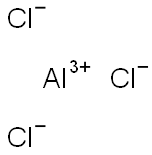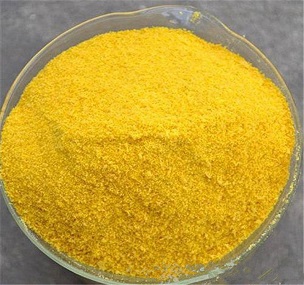General Description
A white to gray powder with a pungent odor. Corrosive to tissue and toxic by ingestion.
Reactivity Profile
ALUMINUM CHLORIDE behaves as an acidic salt. Self-reactive. After long storage in closed containers, explosions often occur upon opening [Chem. Abst. 41:6723d 1947]. Can cause ethylene(also other alkenes) to polymerize violently [J. Inst. Pet. 33:254 1947]. Causes ethylene oxide to rearrange and polymerize, liberating heat [J. Soc. Chem. Ind. 68:179 1949]. Can catalyze violent polymerization of allyl chloride [Ventrone 1971]. Addition to nitrobenzene containing about 5% phenol caused a violent explosion [Chem. Eng. News 31:4915 1953]. Mixtures with nitromethane may explode when organic matter is present [Chem. Eng. News 26:2257 1948].
Health Hazard
Contact with the skin or eyes in the presence of moisture causes thermal and acid burns.
Potential Exposure
It is used as ethylbenzene catalyst, dyestuff intermediate, and detergent alkylate; in making other chemicals and dyes, astringents, deodorants, in the petroleum refining, and the rubber industries
Fire Hazard
Behavior in Fire: Reacts violently with water used in extinguishing adjacent fires
First aid
Move victim to fresh air. Call 911 or emergency medical service. Give artificial respiration if victim is not breathing. Do not use mouth-to-mouth method if victim ingested or inhaled the substance; give artificial respiration with the aid of a pocket mask equipped with a one-way valve or other proper respiratory medical device. Administer oxygen if breathing is difficult. Remove and isolate contaminated clothing and shoes. In case of contact with substance, immediately flush skin or eyes with running water for at least 20 minutes. For minor skin contact, avoid spreading material on unaffected skin. Keep victim warm and quiet. Effects of exposure (inhalation, ingestion or skin contact) to substance may be delayed. Ensure that medical personnel are aware of the material(s) involved and take precautions to protect themselves. Medical observation is recommended for 24 to 48 hours after breathing overexposure, as pulmonary edema may be delayed. As first aid for pulmonary edema, a doctor or authorized paramedic may consider administering a drug or other inhalation therapy
Shipping
UN1726 Aluminum chloride, anhydrous, Hazard class: 8; Labels: 8-Corrosive material. UN2581 Aluminum chloride solution, Hazard class: 8; Labels: 8-Corrosive material
Incompatibilities
A strong reducing agent. Contact with air or water forms hydrochloric acid and hydrogen chloride gas. Reaction with water may be violent. Water, alcohol, and alkenes can cause polymerization. Incompatible with nitrobenzene, organic material, and bases. Attacks metal in presence of moisture, forming flammable hydrogen gas.
Chemical Properties
Aluminum chloride is a noncombustible but highly reactive whitish-gray, yellow, or green powder or liquid. Strong, acidic, irritating odor like hydrochloric acid.The vapor consists of double molecules Al2Cl6 . Soluble in water.
Waste Disposal
May be sprayed with aqueous ammonia in the presence of ice and, when reaction is complete, flushed down drain with running water.
Definition
aluminium chloride: A whitishsolid, AlCl3, which fumes in moist airand reacts violently with water (togive hydrogen chloride). It is knownas the anhydrous salt (hexagonal; r.d.2.44 (fused solid); m.p. 190°C (2.5atm.); sublimes at 178°C) or the hexahydrateAlCl3.6H2O (rhombic; r.d.2.398; loses water at 100°C), both ofwhich are deliquescent. Aluminiumchloride may be prepared by passinghydrogen chloride or chlorine overhot aluminium or (industrially) bypassing chlorine over heated aluminiumoxide and carbon. The chlorideion is polarized by the smallpositive aluminium ion and thebonding in the solid is intermediatebetween covalent and ionic. In theliquid and vapour phases dimer moleculesexist, Al2Cl6, in which thereare chlorine bridges making coordinatebonds to aluminium atoms (seeformula). The AlCl3 molecule can alsoform compounds with other moleculesthat donate pairs of electrons(e.g. amines or hydrogen sulphide);i.e. it acts as a Lewis acid. At hightemperatures the Al2Cl6 molecules inthe vapour dissociate to (planar)AlCl3 molecules. Aluminium chlorideis used commercially as a catalyst inthe cracking of oils. It is also a catalystin certain other organic reactions,especially the Friedel–Craftsreaction.
Hazard
Powerful irritant to tissue; moderately toxic by ingestion. Reacts violently with water, evolving hydrogen chloride gas.
Flammability and Explosibility
Aluminum chloride is not flammable but reacts violently with water, so fires
involving this substance should be extinguished with carbon dioxide or dry
chemicals. Toxic fumes (HCl and reaction products) can be released during fires.
Industrial uses
Aluminium trichloride (AlCl3) act as Lewis acids to a wide range of
electron-pair donors, and this has led to their widespread use as catalysts. In the important Friedel–Crafts
acylation, AlCl3 is used as a strong Lewis acid catalyst in order to achieve the acylation of an aromatic ring.
Industrial uses
Aluminum chloride (AlCl3) is a volatile solid which sublimes at 458 K. The vapour formed on sublimation consists of an equilibrium mixture of monomers (AlCl3) and dimers (Al2Cl6). It is used to prepare the powerful and versatile reducing agent lithium tetrahydridoaluminate (LiAlH4). Aluminium trichloride (AlCl3) act as Lewis acids to a wide range of electron-pair donors, and this has led to their widespread use as catalysts. In the important Friedel-Crafts acylation, AlCl3 is used as a strong Lewis acid catalyst in order to achieve the acylation of an aromatic ring.
storage
work with this substance should be conducted in a
fume hood, and impermeable gloves should be worn at all times when handling AlCl3.
Aluminum chloride should be stored in sealed containers under an inert atmosphere in a cool,
dry place. Care should be taken in opening containers of this compound because of the
possibility of the buildup of HCl vapor from hydrolysis with traces of moisture.
Purification Methods
Sublime it several times in an all-glass system under nitrogen at 30-50mm pressure. It has also been sublimed in a stream of dry HCl and has been subjected to a preliminary sublimation through a section of granular aluminium metal [for manipulative details see Jensen J Am Chem Soc 79 1226 1957]. It fumes in moist air.

